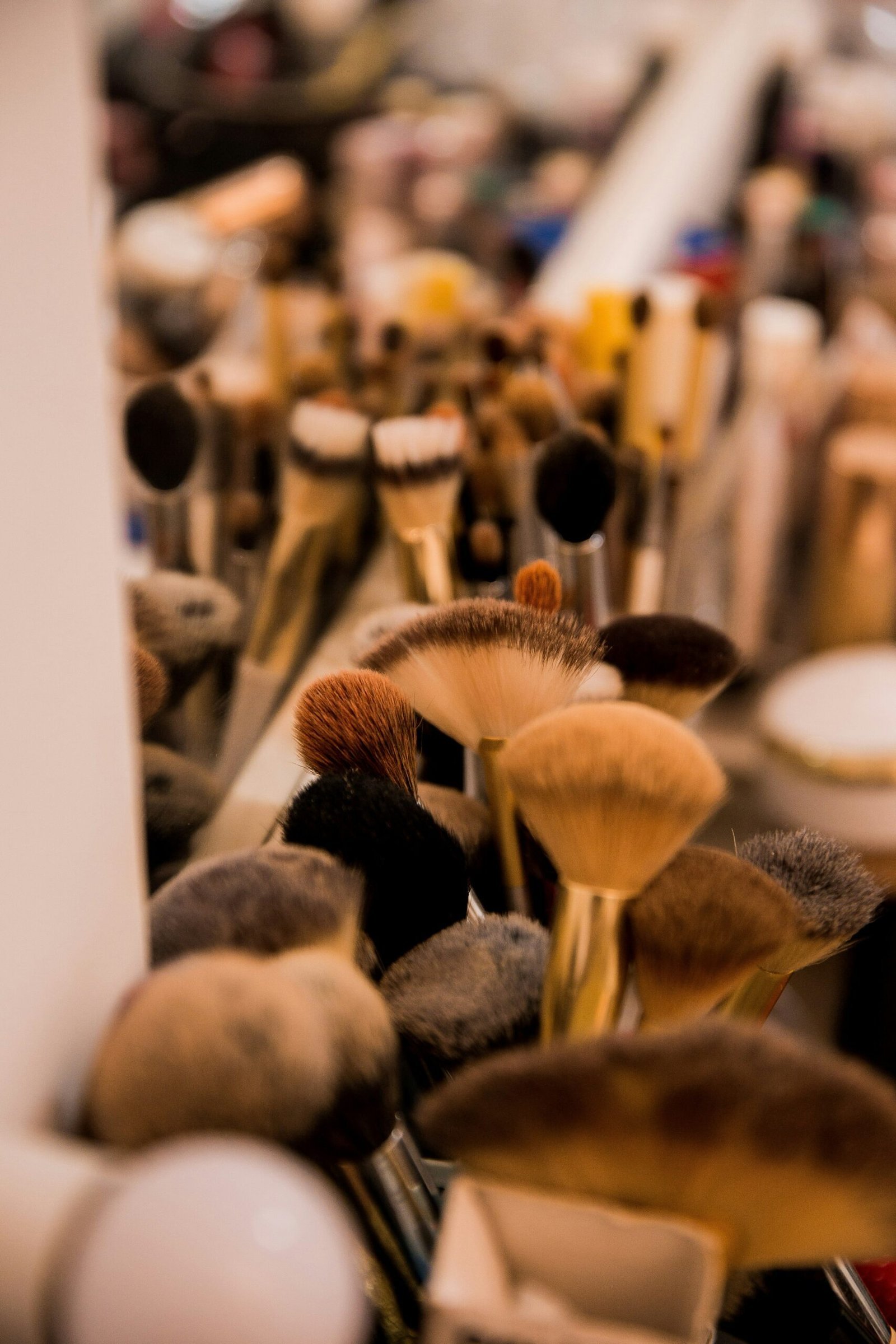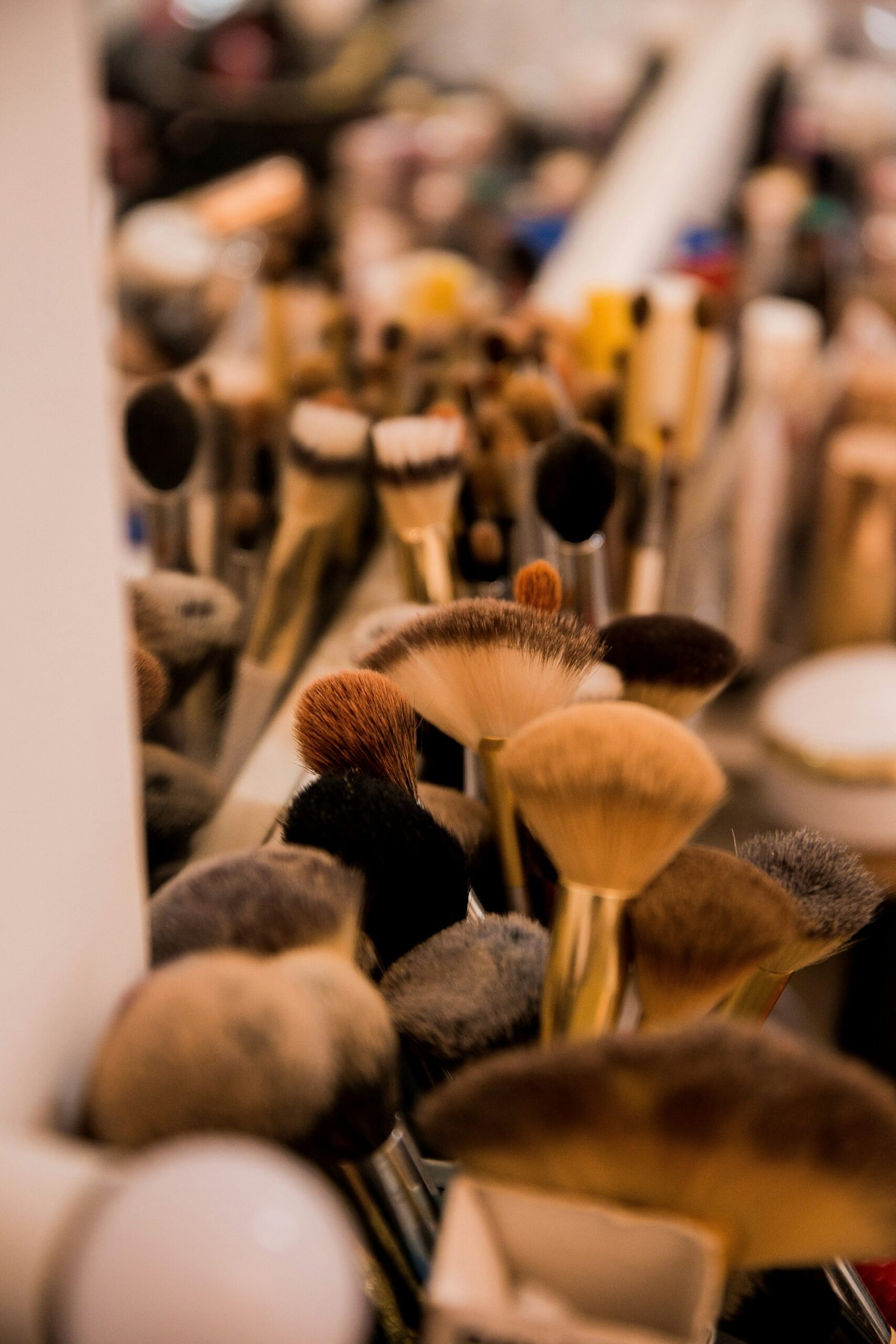
Makeup brushes are indispensable tools in the arsenal of any makeup enthusiast, playing a crucial role in achieving a flawless look. Their importance cannot be overstated, as the right brush can significantly enhance the application of makeup products, ensuring a smooth, even, and professional finish. Understanding the basic types and materials of makeup brushes is essential for anyone looking to elevate their makeup game.
There are a variety of makeup brushes, each designed for a specific purpose. The fundamental types include foundation brushes, powder brushes, blush brushes, eyeshadow brushes, and lip brushes. Foundation brushes, for instance, are typically flat and dense, ideal for applying liquid or cream foundations evenly across the skin. Powder brushes are larger and fluffier, perfect for setting makeup with loose or pressed powders. Blush brushes, often angled or rounded, help in applying blush to the cheeks with precision. Eyeshadow brushes come in various shapes and sizes to cater to different eye makeup techniques, from packing color onto the lid to blending out harsh lines. Lip brushes, on the other hand, offer precise application of lipstick or gloss.
The materials from which makeup brushes are made are also a key consideration. Brushes can be crafted from natural or synthetic fibers, each offering distinct advantages. Natural brushes, typically made from animal hair, are renowned for their softness and ability to pick up and distribute powder products effectively. However, they may not be suitable for cream or liquid products as they can absorb the product, leading to wastage. Synthetic brushes, made from man-made fibers like nylon or polyester, are versatile and ideal for use with liquid, cream, and powder products. They are also more durable and easier to clean, making them a popular choice among both professionals and everyday users.
In summary, the right makeup brushes can make a significant difference in the application and overall look of makeup. By understanding the various types and materials, one can select the appropriate tools to achieve a flawless finish. Whether you prefer natural or synthetic brushes, having a well-rounded collection is essential for any makeup enthusiast looking to perfect their craft.
Foundation Brushes
Foundation brushes are pivotal tools in achieving a flawless base, and they come in various forms to cater to different foundation formulas and desired finishes. Among the most commonly used are flat foundation brushes, stippling brushes, and buffing brushes. Each type offers unique advantages and can significantly influence the final look of your makeup.
Flat foundation brushes are characterized by their dense, tapered bristles. These brushes are particularly effective for applying liquid and cream foundations, as they allow for precise application and an even distribution of product. By using a flat foundation brush, you can achieve a smooth, full-coverage finish. To use this brush, apply the foundation in broad strokes, starting from the center of the face and blending outward.
Stippling brushes, on the other hand, feature a dual-fiber design with varying bristle lengths. This brush is ideal for creating a lightweight, airbrushed effect with liquid or cream foundations. The stippling motion – lightly tapping the brush on the skin – helps to blend the foundation seamlessly, resulting in a natural, dewy finish. Stippling brushes are excellent for those who prefer a buildable coverage that can be layered without looking cakey.
Buffing brushes are typically dense and rounded with a flat or slightly domed top. These brushes are versatile and can be used with liquid, cream, or powder foundations. The key advantage of a buffing brush is its ability to blend foundation into the skin for a flawless, seamless finish. By using circular buffing motions, the brush works the product into the skin, minimizing the appearance of pores and fine lines. This technique is especially beneficial for achieving a smooth, even complexion.
When choosing the right foundation brush, consider the formula of your foundation and the type of finish you desire. Liquid and cream foundations generally pair well with flat and stippling brushes, while powder foundations are best applied with a buffing brush. Ultimately, the right brush can make a significant difference in the application and longevity of your foundation, ensuring a polished and professional look.
Concealer Brushes
When it comes to concealing blemishes, dark circles, and other imperfections, the right concealer brush can make all the difference. Concealer brushes come in various shapes and sizes, each designed for specific applications and areas of the face. Understanding the unique features of each type can help you achieve a flawless, seamless blend.
Flat concealer brushes are among the most common and versatile. With their firm, flat bristles, these brushes are ideal for applying concealer to larger areas of the face. They work particularly well for covering dark circles under the eyes and can also be used to apply a base layer of concealer over blemishes or redness. The flat shape allows for precise application, ensuring that the product is evenly distributed.
Pointed concealer brushes, on the other hand, are designed for more detailed work. The tapered tip of these brushes makes them perfect for targeting small, specific areas, such as individual blemishes or fine lines. The pointed shape allows for precise application, enabling you to concentrate the product exactly where it’s needed without affecting the surrounding area.
Fluffy concealer brushes are another essential tool in your makeup kit. These brushes have soft, loosely packed bristles that are perfect for blending. After applying concealer with a flat or pointed brush, use a fluffy brush to gently buff the edges, creating a smooth, natural finish. This type of brush is also excellent for setting concealer with powder, ensuring that it stays in place throughout the day.
To achieve the best results with concealer brushes, it’s important to use the right techniques. For a smooth blend, start by applying a small amount of concealer to the targeted area. Use a flat or pointed brush to gently pat the product into the skin, building coverage as needed. Then, use a fluffy brush to blend the edges, ensuring there are no harsh lines. By mastering the use of different concealer brushes, you can effectively cover imperfections and achieve a flawless complexion.
Eyeshadow Brushes
When it comes to achieving flawless eye makeup, the right eyeshadow brushes are indispensable tools in any makeup enthusiast’s arsenal. Each brush serves a distinct purpose, contributing to a range of looks from simple everyday styles to intricate, dramatic designs. Understanding the function of each brush can elevate your eyeshadow application technique, ensuring precision and ease.
First and foremost, the flat shader brush is essential for packing eyeshadow onto the eyelid. Its dense, flat bristles allow for even application of color, making it ideal for applying both powder and cream shadows. This brush is perfect for building up intensity, whether you’re aiming for a subtle wash of color or a bold, vibrant look.
Next, the blending brush is crucial for achieving a seamless eyeshadow look. With its soft, fluffy bristles, this brush diffuses harsh lines and blends multiple shades together effortlessly. It’s particularly useful for creating gradient effects and soft transitions between colors. A well-blended eyeshadow can make a significant difference in the overall appearance of your makeup, lending a professional finish to your look.
The crease brush, characterized by its tapered, slightly pointed shape, is designed for adding depth and dimension to the eyes. This brush fits perfectly into the crease of the eyelid, allowing for precise application of darker shades. By accentuating the natural contours of the eye, the crease brush helps achieve a more defined and dramatic effect, perfect for smoky eyes or more elaborate designs.
Finally, the smudge brush is indispensable for creating soft, diffused lines. With its short, dense bristles, it is ideal for smudging eyeliner or eyeshadow along the lash line. This brush is perfect for achieving a sultry, smoky look, as it softens harsh lines and creates a blended, natural appearance. The smudge brush can also be used for adding subtle highlights to the inner corners of the eyes or for detailed work on the lower lash line.
Incorporating these essential eyeshadow brushes into your makeup routine can greatly enhance your ability to create a variety of eye looks. Whether you’re a beginner or a seasoned makeup artist, understanding the role of each brush will help you achieve professional results with ease.
Blush and Contour Brushes
Blush and contour brushes are essential tools for anyone looking to enhance their facial features with precision and artistry. Understanding the different types of brushes available and their specific uses can significantly improve your makeup application, whether you’re aiming for a natural look or something more dramatic.
One of the most popular types of brushes for applying blush is the angled brush. Its slanted bristles allow for easy application and blending, making it perfect for sculpting the cheeks. To use an angled brush, dip it into your blush product and apply it to the apples of your cheeks, sweeping upward towards your temples. This technique helps to lift and define your cheekbones, adding a natural flush to your complexion.
Fan brushes are another versatile tool in the realm of blush and contour application. These brushes have a wide, flat shape that makes them ideal for applying a light dusting of product. When using a fan brush for blush, gently sweep it across the product and then lightly dust it onto your cheeks. This method is particularly useful for achieving a more subtle, natural look. Fan brushes can also be used to apply highlighter to the high points of the face, adding a radiant glow.
Dome-shaped brushes, also known as round contour brushes, are excellent for more precise contouring. Their rounded, dense bristles allow for controlled application and seamless blending. To contour with a dome-shaped brush, apply a contour product to the hollows of your cheeks, along your jawline, and at the edges of your forehead. Blend the product well to avoid any harsh lines, creating a well-defined, sculpted appearance.
For those looking to achieve a dramatic look, layering different types of brushes can be highly effective. Start with the dome-shaped brush for contouring, then use the angled brush to apply blush, and finish with a fan brush for highlighting. This combination will add depth and dimension to your face, enhancing your natural features while allowing for a more sophisticated finish.
Incorporating the right blush and contour brushes into your makeup routine can make a significant difference in the final result. Whether you’re aiming for a natural glow or a more sculpted look, these tools provide the versatility and precision needed to achieve your desired effect.
Highlighter Brushes
Highlighter brushes are essential tools in any makeup enthusiast’s collection, designed to accentuate the high points of the face and achieve a radiant, glowing finish. Among the various types of highlighter brushes, fan brushes, tapered brushes, and small, precise brushes stand out for their unique shapes and applications.
Fan brushes are characterized by their wide, flat design, which makes them ideal for sweeping highlighter across the cheekbones, brow bones, and bridge of the nose. The soft, fanned bristles allow for a light, airy application, ensuring that the highlighter is evenly distributed without looking too harsh. This type of brush is perfect for those who prefer a subtle, natural glow.
Tapered brushes, on the other hand, feature a slender, pointed tip that provides more control and precision. These brushes are excellent for applying highlighter to smaller areas of the face, such as the cupid’s bow, inner corners of the eyes, and along the temples. The tapered shape allows for a concentrated application of product, making it easier to build up intensity and achieve a more dramatic, sculpted look.
Lastly, small, precise brushes are indispensable for detailed highlighting work. These brushes often have dense, compact bristles that pick up and deposit product with accuracy. They are perfect for pinpointing specific areas that require a touch of luminosity, such as the tip of the nose or the center of the chin. Their size and shape also make them ideal for blending highlighter seamlessly into the skin, creating a flawless finish.
In conclusion, choosing the right highlighter brush is crucial for achieving the desired effect. Whether you opt for a fan brush for a soft glow, a tapered brush for precision, or a small brush for detail, understanding the purpose and application of each type will enhance your makeup routine and help you attain a radiant, glowing finish.
Lip Brushes
Lip brushes are indispensable tools for anyone aiming to achieve precise and defined lip looks. These brushes are designed to provide control and accuracy, ensuring an impeccable application of lipstick, gloss, and liner. Lip brushes can be classified into various types, each serving a unique purpose to enhance your lip makeup routine.
The retractable lip brush is a popular choice for its convenience and portability. This type of brush comes with a protective casing that retracts to cover the bristles when not in use, making it ideal for on-the-go touch-ups. The retractable mechanism also helps maintain the brush’s hygiene by keeping it free from dust and debris.
Another commonly used lip brush is the flat lip brush. Characterized by its firm, tapered bristles, the flat lip brush excels in defining the lip contours and filling in the lips with a smooth, even layer of product. Its shape allows for precision in creating sharp lines at the edges of the lips, which is particularly beneficial when applying bold or dark lip colors that require a meticulous outline.
When it comes to applying lipstick, using a lip brush can significantly enhance the final look. Begin by loading the brush with your chosen lipstick, starting from the center of the lips and working outward. This technique ensures an even distribution of color and helps prevent the product from feathering or bleeding outside the lip line. For a more defined look, use the tip of the brush to trace the natural lip line before filling in the rest of the lips.
For lip gloss application, a lip brush allows for a controlled amount of product, preventing the lips from appearing overly glossy or sticky. Similarly, when applying lip liner, a fine-tipped lip brush can blend the liner seamlessly into the lipstick, creating a cohesive and polished appearance.
Incorporating a lip brush into your makeup routine can elevate your lip looks to a professional level, providing the precision and control needed for flawless application. Whether you opt for a retractable or flat lip brush, mastering this tool can transform your approach to lip makeup, ensuring your lips always look their best.
Care and Maintenance of Makeup Brushes
Proper care and maintenance of makeup brushes are crucial for extending their lifespan and ensuring a hygienic application. Regular cleaning not only prevents the build-up of bacteria and old makeup but also ensures that your brushes perform at their best. Different types of bristles, whether synthetic or natural, require specific cleaning methods to keep them in optimal condition.
For synthetic bristles, which are often used with liquid and cream products, a gentle soap or a dedicated brush cleaner is recommended. Start by rinsing the bristles under lukewarm water, being careful to avoid getting water into the ferrule (the metal part that holds the bristles). Apply a small amount of soap or cleaner to the bristles and gently massage them to remove product build-up. Rinse thoroughly until the water runs clear and reshape the bristles before laying the brush flat to dry.
Natural bristle brushes, commonly used with powder products, need a bit more delicate care. These brushes benefit from a mild shampoo or a specific cleaner designed for natural hair. The cleaning process is similar: rinse under lukewarm water, apply a small amount of cleaner, and gently work it through the bristles. Rinse well and reshape the bristles, then allow the brush to dry flat to maintain its shape and integrity.
Regular cleaning is essential. Ideally, brushes used with liquid and cream products should be cleaned weekly, while those used with powders can be cleaned bi-weekly. Additionally, deep cleaning should be complemented with daily maintenance using a quick-drying brush cleaner to remove surface residue.
Proper storage is equally important. After thoroughly drying, store your brushes in a manner that protects the bristles from dust and deformation. Use a brush holder or a roll-up case that keeps them upright and spaced out. Avoid storing brushes in airtight containers, as this can foster bacteria growth.
By following these care and maintenance tips, your makeup brushes will remain hygienic and perform optimally, ensuring a flawless makeup application every time.


